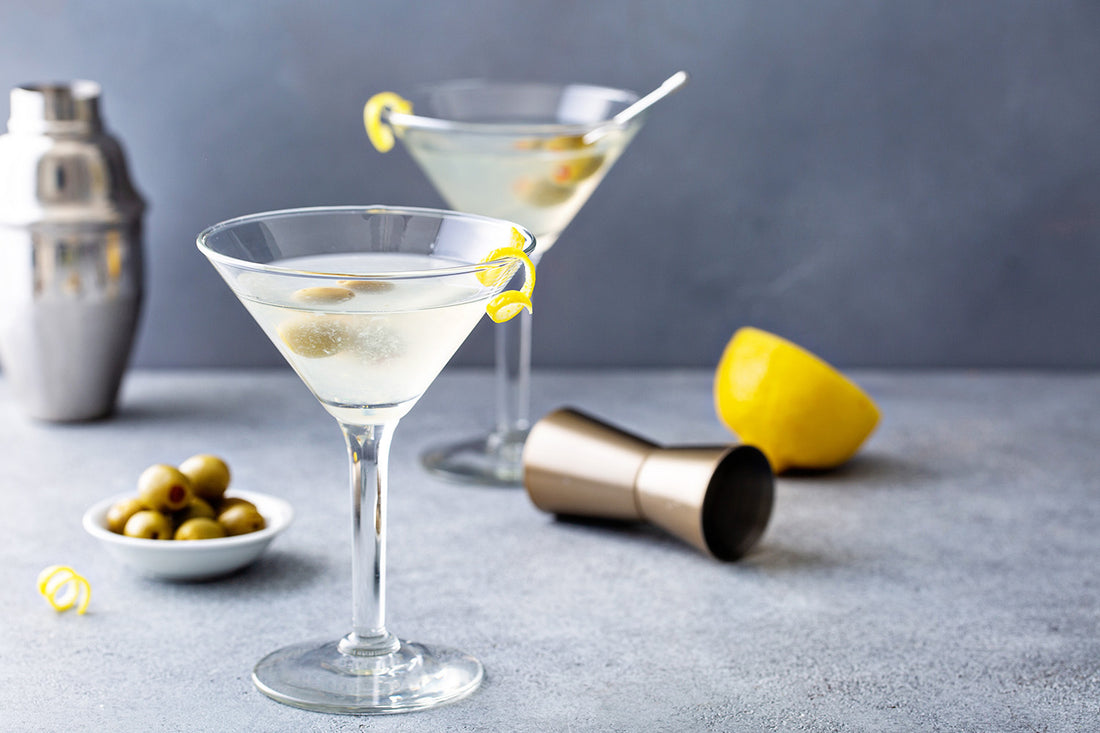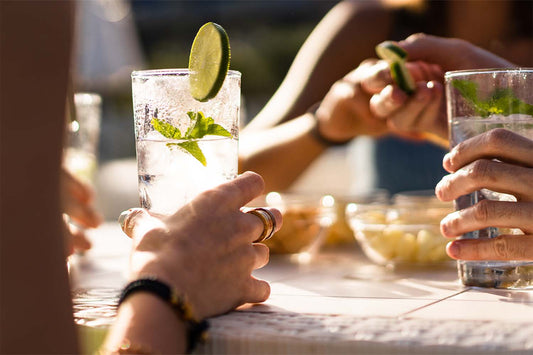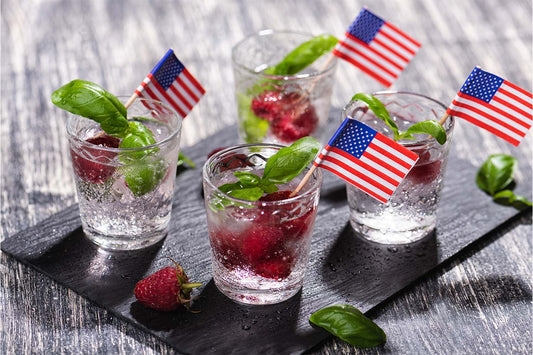Everyone has their own idea of the perfect Martini, and they are possibly one of the most well-known cocktails in the world (thanks to a certain British special agent).
But what is a Martini, really? What ingredients are mandatory in order to call a cocktail a Martini, and which ones allow you to take some artistic license? If you’ve been looking to learn a little more about the Martini and how you can customize it to fit into your life, Haus has everything you’ll want to know.
The History of the Martini
Unlike many other popular cocktails, the Martini doesn’t have clear, traceable roots. In fact, there is no definite, agreed-upon story behind its origins, and it’s believed to have started in a few different places around the same time. What isn’t in contention is that the Martini is old, as its history stretches back for over a hundred years.
That lack of an origin story is one of the primary reasons there are so many claims for how to make the “correct” Martini. Much of what people think is the “right way” to do it relies on the part of the world they grew up in. In a way, everyone’s version of their perfect Martini is similar to how they feel about comfort food.
That’s not to say that there aren’t theories on how the Martini came to be. One of the most common theories is that the Martini is actually an evolution of the Manhattan, a cocktail made with bourbon or rye whiskey, vermouth, and bitters.
Ironically, while the Martini is now known mostly for being dry, what’s thought to be one of the original versions was much sweeter. A recipe from 1891 listed Old Tom gin (a “sweeter” gin), Italian sweet vermouth, a twist of lemon, and a few drops of Angostura bitters.
What Makes Up a “Proper” Martini?
In its most basic form, a Martini is made from two primary ingredients — gin and vermouth — and served in that iconic, V-shaped Martini glass. For many people, equal parts of these two ingredients are non-negotiable (although we think there is plenty of room for change and creativity, even with the classic Martini).
In fact, these days, the vodka Martini is nearly as popular as the original gin Martini recipes.
Gin Basics
The origins of gin can be traced back to the 16th Century and a Dutch chemist named Dr. Franciscus Sylvus. The spirit is still made similarly, primarily from a “mash” (made of cereal grains, like barley, corn, rye, and wheat) combined with juniper berries and various botanical flavors. The result is a clear, light liquor that often tastes just a little bit like pine (thanks to the juniper).
When shopping for gin, there are four different types you’re likely to see on the shelf — London Dry, Plymouth, Old Tom, and Genever. Each has a slightly different flavor profile (London Dry is more juniper-forward, for instance, while Old Tom is a sweeter style gin). Try them out and see which one you like the best!
Vermouth Basics
Vermouth is a little more complicated, and the variety of vermouth you use can have a big impact on the overall flavor of the Martini. Overall, vermouth is a type of fortified wine that gets its taste from a combination of herbs and spices. There are two main categories of vermouth — dry (white) and sweet (red).
Dry vermouth comes originally from France, and it lends a dry, floral flavor to the liquor. Sweet vermouth is sweeter with more spices and comes from Italy. When it comes to Martinis, dry vermouth is far more common. Sweet vermouth is found in other cocktails, like the Negroni.
Both dry and sweet vermouth are also frequently enjoyed as an aperitif.
Dry Versus Dirty
If you’ve ever ordered a Martini at a bar, chances are you’ve been asked whether you want it “dry” or “dirty.” If you’re anything like us, you’ve probably answered one or the other without actually knowing what either meant.
Let’s start with the basics of a Dry Martini. How dry a Martini is relates to how much dry vermouth was used to make it. The less vermouth used, the drier of a Martini it is.
If you want your Martini to be a little sweeter, you can ask for a Wet Martini, which increases the ratio of vermouth. On the other hand, Dirty Martinis often use olive brine in place of (or alongside) the vermouth. Just a splash of olive juice adds acid and salt to the cocktail.
Martinis can also be made “extra” dry or dirty, increasing the ratio even further. If you’re still unsure, ask your bartender for suggestions and try a few out until you can hone in on what type of Martini you’re really into.
How Can You Garnish Your Martini?
There are plenty of ways to garnish your Martini, which really comes down to your personal taste. For many people, enjoying the garnish at the end of the drink is one of the best parts of enjoying the cocktail. That’s why olives (especially blue cheese-stuffed olives) are so popular.
Other ways to garnish your Martini include a lemon twist or cocktail onions. In fact, pickled onions are at the heart of one of the more unusual savory Martini variations, the Gibson.
Don’t be afraid to get creative and garnish your Martini with anything you’d like! You can even skip the garnish if you want, as it’s not an essential part of making this cocktail shine.
The Big Question — Shaken or Stirred?
Ask any bartender their opinion on whether a Martini should be shaken or stirred, and they’re likely to have a very strong idea of the right way to do it.
That’s because one of the first cocktail-making rules most bartenders learn is which drinks should be shaken and which should be stirred. The general rule of thumb is that cocktails made with only alcohol-based ingredients (like spirits, vermouths, and liquors) should only be stirred. On the other hand, if non-alcohol ingredients are added to the mix (cream, egg white, and citrus juices), shaking would be more appropriate.
The benefit of stirring over shaking is maintaining the integrity of the ingredients. Shaking can change the texture of the cocktail by adding tiny air bubbles (a process known as aeration). Stirring helps to chill the cocktail consistently without those texture changes.
Although how you make your Martini is up to you, the consensus seems to be that they taste best when stirred. Just combine two parts gin to one part vermouth in a mixing glass, add ice, stir well, and strain into a Martini glass.
Twists on the Classic Martini
Really, what is a Martini if you don’t enjoy it? The best part about making cocktails, especially when you make them in the privacy of your own home, is that you can customize them so they taste exactly how you want them to.
An exciting way to lighten up a Martini while cutting down on the alcohol (so that you can enjoy more with less risk of a hangover) is to substitute the vermouth for another aperitif with a slightly different flavor. Try mixing it up with our Spiced Cherry, Pomegranate Rosemary, or Ginger Yuzu, and don’t be afraid to experiment with ratios until you find your perfect Martini.
As we mentioned, another twist on the classic Martini is making it with vodka instead of gin. This is an especially great variation for people who don’t love the juniper flavor of gin. Substituting vodka gives the cocktail a cleaner, smoother taste, which can allow the flavor of the vermouth (or the aperitif you’re substituting instead) to really shine.
You can even combine both vodka and gin, which is part of James Bond’s famous Vesper Martini (in addition to Kina Lillet, which is usually replaced with Lillet Blanc or another aperitif).
How To Change Your Views on Drinking Culture
Part of what we love the most about aperitif culture is how it changes how we think about drinking. Instead of having the goal be just to get drunk, enjoying an aperitif with friends puts the focus on the connection instead of the drink. When we can combine the benefits of social connection with some of the potential health benefits of enjoying alcohol in moderation, you hit a sweet spot.
Try inviting some friends over and serving them an aperitif. All you need to do is put on some non-distracting music, maybe start a fire, and then catch up. It’s incredible how much of the little stuff we miss when we live our lives running from one thing to another. It’s understandable, as the world seems to be set up to encourage hustle culture, but it’s also not conducive to creating genuine, real-world connections.
In Summary
What is a Martini? In addition to being one of the classic cocktails (and a favorite of James Bond), Martinis are just made up of two simple ingredients — gin and vermouth.
However, just because that’s how Martinis were designed initially doesn’t mean you have to stick with outdated recipes that you don’t enjoy. Next time, try switching out the vermouth for one of our aperitifs, and craft a lighter cocktail that you can enjoy with friends (without feeling terrible the next day).
Sources:
The Science of a Hangover | Northwestern Medicine




